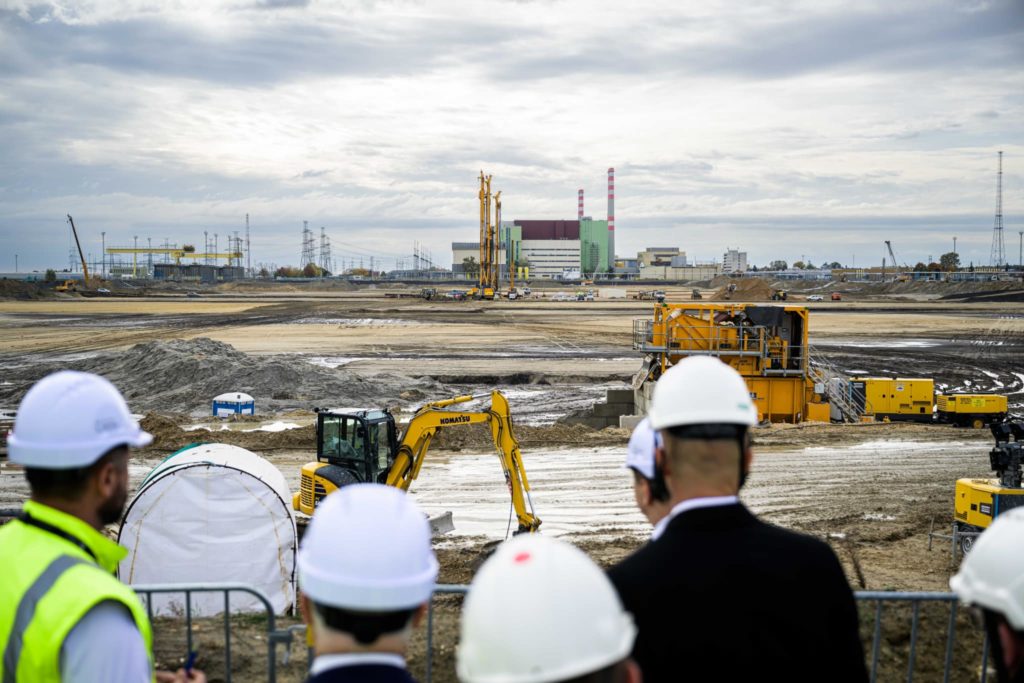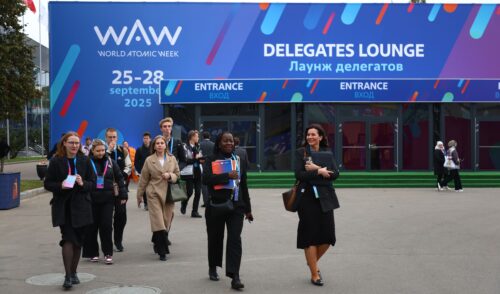
Paks II Picks Up Pace
back to contentsThe Paks II NPP project has made much progress over the past year, with many milestones passed at the construction site, meetings held between Rosatom head Alexey Likhachev and the Hungarian leadership, and Russian and Hungarian parties mutually taking part in business events. Here is our short review of 2024.
Construction
In April, work began in Russia to manufacture a reactor for the first power unit of the plan as Rosatom steel makers proceeded with forging a batch of blanks for the shells, an important structural element of the reactor pressure vessel. Paks II CEO and Chairman Gergely Jákli, who was present at the start of production ceremony, said: “We are working to ensure that the new power units at the Paks NPP will be connected to the grid by the early 2030s. The work is simultaneously underway at the construction site in Hungary and thousands of kilometers away from it, in Saint Petersburg.”
In August, the first piece of large-size equipment, a molten core catcher, arrived at the Paks II construction site. Being an important part of the passive safety system, the core catcher is installed at the bottom of the concrete pit, right under the reactor, and filled with the sacrificial material. In case of a core meltdown, the core catcher reliably retains corium fragments and keeps them inside the reactor containment.
“It is deeply symbolic that the first piece of large-size equipment that has arrived at the Paks II construction site belongs to the plant’s safety system. The foundation for safe and reliable operation of the country’s new nuclear station is therefore laid long before it is connected to the grid,” said Vitaly Polyanin, Vice President of AtomStroyExport (ASE) and Director of Paks II Construction Project.
Works at Units 5 and 6 of the nuclear power plant are proceeding on schedule as soil excavation and stabilization operations are underway and auxiliary buildings being erected. The first concrete for Unit 5 is scheduled to be poured in the first quarter of 2025.

In late November, the Hungarian Atomic Energy Authority (OAH) approved a preliminary safety analysis report (PSAR) for the Paks II project. The approval received allows for the first concrete pouring at the construction site. Commenting on the approval of the Paks II PSAR, Hungarian Minister of Foreign Affairs and Trade Péter Szijjártó stressed that this was one of the most important milestones in the nuclear power plant construction. In order to prepare the preliminary safety assessment report, it was first necessary to install an impervious blanket and analyze data obtained after the soil stabilization. Szijjártó emphasized that the PSAR was “a profound document of half a million pages.” The minister recalled that, once the first concrete was poured, the Paks II NPP would be officially classified as a nuclear power plant under construction according to the IAEA standards.
Business activity
In late February, Rosatom organized a seminar for potential suppliers to the Paks II Nuclear Power Plant. It was attended by over 350 representatives of 180 companies from Hungary and other countries. The attendees were told about the partnership options and terms, supplier requirements, contracting and on-site operating procedures. Paks II CEO and Chairman Gergely Jákli said: “New market opportunities are opening up for the companies involved in the project as many countries in Europe and around the world have made a decision to extend the service life of their operating power reactors or build new nuclear power plants.”
In late March, the Russian Association of Nuclear Host Communities and the Hungarian Social Monitoring, Information and Community Development Association (TEIT) signed a roadmap of joint activities for 2024 on the sidelines of the ATOMEXPO 2024 international forum. The parties plan to carry out joint projects in the fields of culture, education, environment and sports under the current memorandum of cooperation signed in 2014.
“The development of sister ties between Russian and Hungarian cities strengthens contacts between municipalities and delivers tangible results in improving the quality of people’s life, creates new opportunities for the development of communities, and builds trust in nuclear energy among local people,” emphasized Géza Filvig, Chairman of TEIT and Mayor of the Hungarian city of Kalocsa. Russia and Hungary have several sister cities. They are Novovoronezh and Paks, Polyarnye Zori and Kalocsa, Desnogorsk and Gerjen, Volgodonsk and Tamási.
In September, Rosatom experts spoke at a business forum in Budapest about the opportunities for cooperation between the Russian nuclear corporation and its international partners. The event was attended by representatives of over 50 large companies, both current and potential suppliers to the Paks II project from Hungary, Russia and other countries, as well as ministries, agencies and business communities of the two countries.
Vitaly Polyanin, Vice President of AtomStroyExport and Director of Paks II Construction Project:
“The project passed three major milestones in 2024 as the soil stabilization phase was completed at Unit 5, a molten core catcher for the same unit was delivered to the site, and production of the reactor pressure vessel began. Intensive preparations are currently underway to pour the first concrete.”
Alexander Merten, Senior Vice President for International Business Development at AtomStroyExport, said that Rosatom was a global leader by the number of power reactors under construction abroad. The nuclear corporation has secured orders for 33 large power reactors and 6 small modular reactors in 10 countries. “We feel the support of the Hungarian government. Paks II is for us a strategic construction project and the first Generation III+ VVER 1200 project in the EU, so it is given special attention,” Alexander Merten emphasized.

Meetings and negotiations
Paks II is one of the priority areas of the Russian-Hungarian cooperation, for which reason the project is under the spotlight of attention from the Hungarian government. Rosatom Director General Alexey Likhachev has had regular meetings with Hungarian Minister of Foreign Affairs and Trade Peter Szijjártó throughout the year.
At a meeting in March, the parties praised the pace of work at the new Paks NPP power units. “We are proud that a truly international project is being implemented in Paks. Apart from the Russian general contractor, the chain of subcontractors includes German, French, Austrian, Swedish and American companies,” Peter Szijjártó said at the meeting.
At a meeting in July, Alexey Likhachev and Peter Szijjártó emphasized the importance of continuous dialogue and acknowledged the interest in the project delivery from both project stakeholders and international partners. Paks II is the first in the European Union to receive a construction license for Russian-designed nuclear power units.
Péter Szijjártó, Minister of Foreign Affairs and Trade of Hungary:
“We plan to increase the share of electricity from nuclear to 70 % — this will happen in the next decade.”
* from the speech made at the Saint Petersburg International Gas Forum




